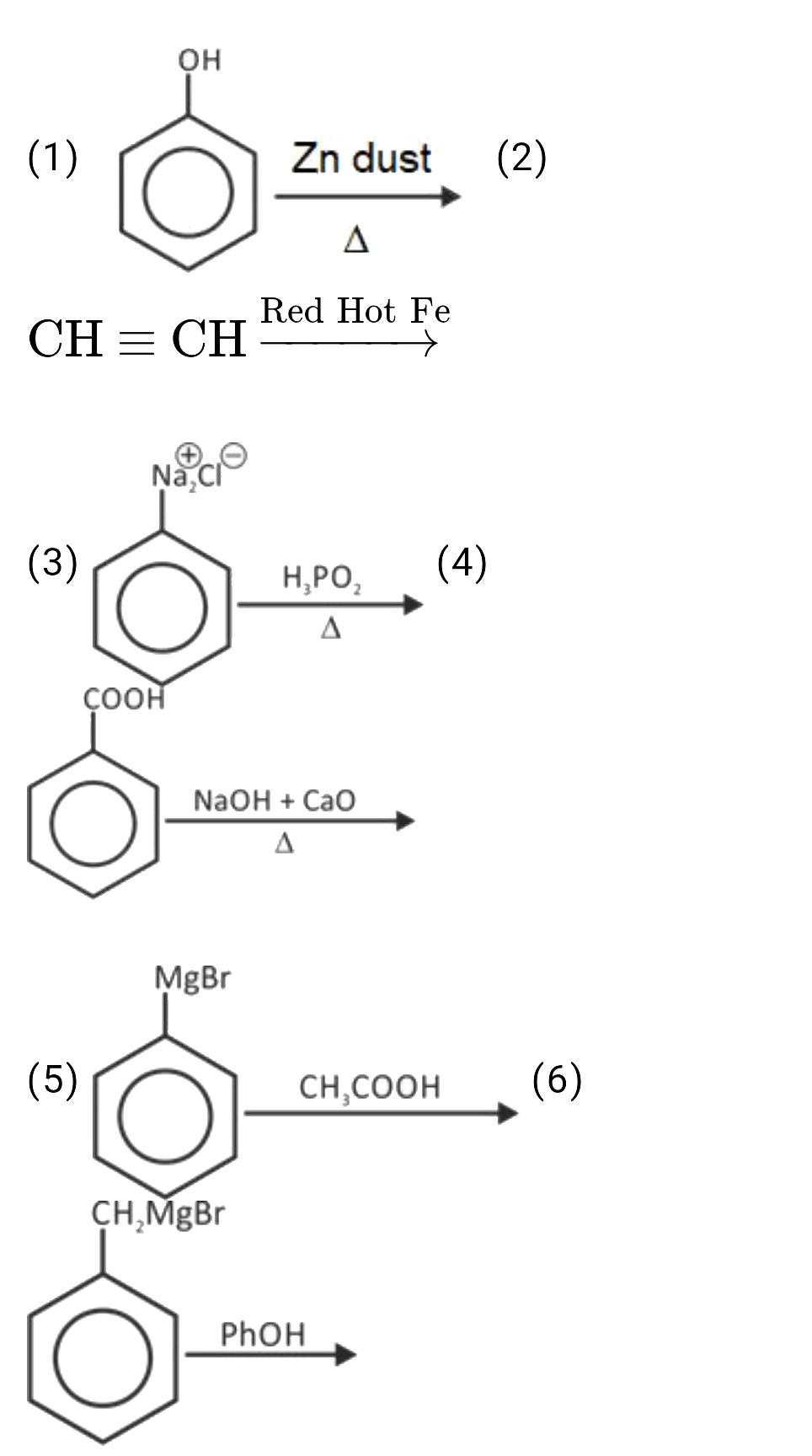Phenyl subsituted hydrocarbon (A) molecular mass 120 on monobromination can give 3 isomeric products only Major product (B) on treatment with sodium gives (C). Find (A) (B) and (C)
To solve the problem, we need to identify the phenyl substituted hydrocarbon (A), the major product from its monobromination (B), and the product formed when (B) is treated with sodium (C).
Step 1: Determine the structure of hydrocarbon (A)
- Given that (A) is a phenyl substituted hydrocarbon with a molecular mass of 120 g/mol.
- The molecular formula of the phenyl group (C6H5) has a mass of 77 g/mol (6 carbons and 5 hydrogens).
- Therefore, the remaining mass for the substituent is 120 - 77 = 43 g/mol.
- The substituent that fits this mass is C3H7 (which can be represented as either isopropyl (CH(CH3)2) or n-propyl (CH2CH2CH3)).
Step 2: Identify possible structures for (A)
- The two possible structures for (A) can be:
1. Isopropylbenzene (C6H5C(CH3)2)
2. Propylbenzene (C6H5CH2CH2CH3)
Step 3: Monobromination of (A)
- Upon monobromination, we need to consider that (A) can yield three isomeric products.
- For isopropylbenzene:
1. Bromination at the benzylic position (C6H5C(CH3)Br)
2. Bromination at the ortho position (C6H4BrC(CH3)2)
3. Bromination at the para position (C6H4BrC(CH3)2)
- For propylbenzene:
1. Bromination at the benzylic position (C6H5CH2Br)
2. Bromination at the 1-position (C6H4BrCH2CH2CH3)
3. Bromination at the 2-position (C6H4BrCH2CH2CH3)
- The major product (B) will be the one that forms the most stable free radical during the bromination process.
Step 4: Identify the major product (B)
- The major product will be the one that forms a tertiary free radical, which is more stable than primary or secondary radicals.
- If we consider isopropylbenzene, the bromination at the benzylic position yields a tertiary radical, making it the major product (B).
Step 5: Treatment of (B) with sodium
- The major product (B), which is isopropylbenzene with a bromine at the benzylic position, will undergo a Wurtz reaction when treated with sodium.
- In the Wurtz reaction, two molecules of the brominated product couple together, resulting in the formation of a new hydrocarbon (C).
- The product (C) will be isopropylbenzene (C6H12) after coupling.
Final Answers:
- (A) = Isopropylbenzene (C6H5C(CH3)2)
- (B) = 1-Bromo-2-methylpropane (C6H5C(CH3)Br)
- (C) = Ethane (C2H6)
- Given that (A) is a phenyl substituted hydrocarbon with a molecular mass of 120 g/mol.
- The molecular formula of the phenyl group (C6H5) has a mass of 77 g/mol (6 carbons and 5 hydrogens).
- Therefore, the remaining mass for the substituent is 120 - 77 = 43 g/mol.
- The substituent that fits this mass is C3H7 (which can be represented as either isopropyl (CH(CH3)2) or n-propyl (CH2CH2CH3)).
- The two possible structures for (A) can be:
1. Isopropylbenzene (C6H5C(CH3)2)
2. Propylbenzene (C6H5CH2CH2CH3)
- Upon monobromination, we need to consider that (A) can yield three isomeric products.
- For isopropylbenzene:
1. Bromination at the benzylic position (C6H5C(CH3)Br)
2. Bromination at the ortho position (C6H4BrC(CH3)2)
3. Bromination at the para position (C6H4BrC(CH3)2)
- For propylbenzene:
1. Bromination at the benzylic position (C6H5CH2Br)
2. Bromination at the 1-position (C6H4BrCH2CH2CH3)
3. Bromination at the 2-position (C6H4BrCH2CH2CH3)
- The major product will be the one that forms a tertiary free radical, which is more stable than primary or secondary radicals.
- If we consider isopropylbenzene, the bromination at the benzylic position yields a tertiary radical, making it the major product (B).
- The major product (B), which is isopropylbenzene with a bromine at the benzylic position, will undergo a Wurtz reaction when treated with sodium.
- In the Wurtz reaction, two molecules of the brominated product couple together, resulting in the formation of a new hydrocarbon (C).
- The product (C) will be isopropylbenzene (C6H12) after coupling.
- (A) = Isopropylbenzene (C6H5C(CH3)2)
- (B) = 1-Bromo-2-methylpropane (C6H5C(CH3)Br)
- (C) = Ethane (C2H6)
Topper's Solved these Questions
- HYDROCARBONSBOOK - AAKASH INSTITUTE ENGLISHCHAPTER - HYDROCARBONSEXERCISE - SECTION-J AAKASH CHALLENGERS QUESTIONS
5 Videos
- HYDROCARBONSBOOK - AAKASH INSTITUTE ENGLISHCHAPTER - HYDROCARBONSEXERCISE - Try yourself
78 Videos
- HYDROCARBONSBOOK - AAKASH INSTITUTE ENGLISHCHAPTER - HYDROCARBONSEXERCISE - SECTION-H MULTIPLE TRUE-FALSE TYPE QUESTIONS
2 Videos
- HALOALKANES AND HALOARENES BOOK - AAKASH INSTITUTE ENGLISHCHAPTER - HALOALKANES AND HALOARENES EXERCISE - ASSIGNMENT SECTION -D
15 Videos
- HYDROGENBOOK - AAKASH INSTITUTE ENGLISHCHAPTER - HYDROGENEXERCISE - ASSIGNMENT (SECTION - D) (Assertion-Reason Type question)
15 Videos
Similar Questions
Knowledge Check

Find the major product 'C':A B
B C
C D
D
Find the product C(major)
 .
.
View SolutionIdentify number of reactions that can give benzene as major product

View SolutionWhich of the following alkane upon dichlorination can give only two products ?
View SolutionA hydrocarbon of melecular formula C5H10 on monochlorination gives one product and on dichlorination gives three products (excluding stereoisomers) . Identify the hydrocarbon .
View SolutionAn alkali metal A gives a compound B (molecular mass = 40) on reacting with water. The compound B gives a soluble compound C on treatment with aluminium oxide. Identify A, B and C and give the reactions involved.
View Solutiona. Give the structure of lowest molecular mass and optically active alkyne.
b. Give the structure of unsaturated hydrocarbon with lowest molecular mass showing diastereomers.
c. Give the structure of alkyne that gives the same product on reaction with either H2+Ni2B or K+C2H5OH.
d. Give the structure of alkyne that gives the same single product on reaction with either (B2H6/THF+H2O2/ӨH) or dil. H2SO4/Hg2+/H⊕.
e. Give the structure of alkyne that gives the same two products with either of the reagents in (d).
View Solution
Give the products (B) and (C) in the above reaction.
View Solution

